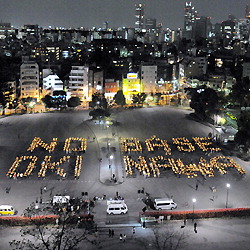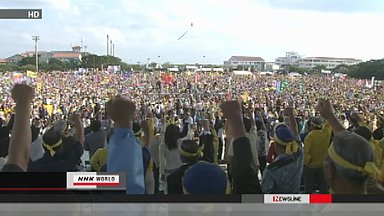According to reports from Okinawan and Japanese sources, today (yesterday, in Japan) approximately 95,000 people attended a mass rally in Tomitan to oppose the U.S. military bases in Okinawa. Several English language news stories are included below. They report the numbers as 90,000, but there were thousands more who were unable to make it to the rally site because of the congestion.
There were solidarity demonstrations in a number of Japanese cities. Above is a photo from the Mainichi Shimbun from a rally in Tokyo. Today at the Japanese Consulate in Honolulu, at 6:00 pm there will be a vigil in solidarity with Okinawa. Join us!
>><<
http://www.nhk.or.jp/daily/english/25_15.html
Anti-US base rally held in Okinawa
Okinawa Governor Hirokazu Nakaima has called on the government of Prime Minister Yukio Hatoyama to move the US Futenma air station out of Okinawa.
Nakaima spoke at a massive rally in the village of Yomitan on Sunday. The participants called on the Japanese and US governments to move the US Marine Corps Futenma Air Station out of Okinawa or overseas.
Nakaima said it is very unfair that US bases have remained in the prefecture long after the end of World War Two.
He said the issue does not only concern Okinawa, and he believes the enthusiasm shown at the rally will prompt both the Japanese and US governments to come up with an acceptable solution.
The 2 countries agreed in 2006 to move the Futenma air station from the crowded city of Ginowan to a coastal area near the US Camp Schwab in Nago, also in Okinawa.
The participants adopted a resolution demanding that the 2 governments give up relocating the base within Okinawa and move it out of the prefecture or overseas.
2010/04/26 00:22(JST)
+++
http://hosted.ap.org/dynamic/stories/A/AS_JAPAN_US_MILITARY?SITE=MIDTN&SECTION=HOME&TEMPLATE=DEFAULT
Apr 25, 12:05 PM EDT
Okinawans rally for US base to be moved off island
By MARI YAMAGUCHI
Associated Press Writer
TOKYO (AP) — Tens of thousands of Okinawan residents and leaders demanded a U.S. Marine base be moved off the island at a mass rally Sunday, inflamed by speculation the government may finally accept a plan to merely relocate it to another part of the southern Japanese island.
Okinawans have long complained of the burden of hosting most of 47,000 American troops in Japan under a security pact. Okinawa was under U.S. occupation until 1972 and many residents resent the U.S. military presence as legacy of Japan’s World War II defeat.
Tokyo and Washington agreed in 2006 to move sprawling Futenma Marine Corps air field to a less crowded part of Okinawa and to move 8,000 of its Marines to Guam. But when Prime Minister Yukio Hatoyama took power last September he said he would not honor the deal struck by his political rivals and promised to find a site off Okinawa for the troops.
“We will not allow the base to stay here,” Okinawa Gov. Hirokazu Nakaima told the cheering crowd. “We want the Hatoyama government to keep its promise.”
Hatoyama has delayed a decision in the face of rejection by potential relocation sites.
About 90,000 people from across the island gathered in the town of Yomitan, carrying banners and placards with anti-U.S. military slogans and demanding Hatoyama keep his promise and move the Futenma base outside the island.
The protesters were particularly upset as media reports said earlier Sunday that Foreign Minister Katsuya Okada had told U.S. Ambassador John Roos last week that Tokyo was moving to accept much of the 2006 deal.
Okada acknowledged he met with Roos, but denied he made such concessions as reported.
“No to a new base! No to a relocation within the island!” Nago Mayor Susumu Inamine said, criticizing Hatoyama’s government for “playing with the Okinawans’ feelings.”
Hatoyama’s attempt to please both Washington and Okinawa has apparently frustrated both. His perceived lack of leadership and indecisiveness have caused support for his Cabinet to fall to around 30 percent in recent public polls, down sharply from around 70 percent last year.
Hatoyama has also faced growing pressure from Washington to observe the 2006 agreement, which U.S. officials say is the only “viable” option.
But he has been unable to obtain consent for any potential sites or even enter talks with local officials. Hatoyama on Saturday denied accepting the earlier agreement and that he would closely monitor Sunday’s rally.
Hatoyama, who has promised to resolve the dispute by the end of May, told Friday’s parliamentary session that he would “stake his job” to do so. Opposition leaders have demanded his resignation if he fails to meet the deadline.
Reported options include a temporarily transfer of some of Futenma’s heliport functions to nearby Camp Schwab or reclaiming land off the U.S. Navy’s White Beach facility on Okinawa.
The government is also considering Tokunoshima island, north of Okinawa, but residents held a massive protest this month and local officials rejected Tokyo’s request for talks.
+++
http://home.kyodo.co.jp/modules/fstStory/index.php?storyid=497662
Okinawans seek U.S. base removal from prefecture in mass rally
YOMITAN, Japan, April 25 KYODO
By Maya Kaneko
About 90,000 local residents and politicians in Okinawa called for the removal of a U.S. Marine base located in a crowded residential area in the southernmost prefecture in a mass rally Sunday, venting their frustration against the central government which is struggling to resolve where the base should go.
Many participants in the rally in the village of Yomitan were clad in yellow, the symbol color of the protest rally to demonstrate their ”yellow card” warning against Prime Minister Yukio Hatoyama’s government. They excitedly cheered for and gave applause to speakers.
Okinawa Gov. Hirokazu Nakaima, who has conditionally accepted an existing Japan-U.S. plan to relocate the U.S. Marine Corps’ Futemma Air Station, urged Hatoyama to remove as soon as possible the danger of accidents and crimes involving the Futemma base and called for nationwide support to ease base-hosting burdens on Okinawans.
The governor said he cannot allow the base to continue to sit in the densely populated area of Ginowan if the current efforts by the premier to transfer the facility out of the prefecture get bogged down.
“Some Cabinet ministers have indicated their tolerance for the possibility of Futemma airfield remaining as it is, but I say absolutely no to that,” Nakaima told the rally participants. “I want the prime minister to never give up and honor his pledge.”
Before his Democratic Party of Japan came to power last September, Hatoyama promised Okinawa people that he will try to transfer the Futemma airfield out of the prefecture or even abroad. The premier has vowed to settle the issue by the end of May.
Nakaima also said burdens to host U.S. military bases in Okinawa have exceeded the capacity of locals and asked people in other parts of Japan to ”lend a helping hand” to ease them.
”This is not a problem that only concerns Okinawans. The safety of each Japanese individual is connected to Okinawa,” the governor said, referring to the Japan-U.S. security arrangement.
The island prefecture hosts about 75 percent of the land area used for U.S. military facilities in Japan and half of the around 50,000 U.S. service personnel in the country.
Under the 2006 bilateral accord, the heliport functions of the Futemma base would be transferred from Ginowan to a coastal zone in the Marine’s Camp Schwab in Nago, also in Okinawa, by 2014.
The United States has maintained its position that it prefers the existing plan.
The governor told reporters after the gathering while it has become ”extremely difficult” to implement the current Futemma relocation plan as it is, he expects Hatoyama to respond to the wishes of the 90,000 attendants and ”find the most appropriate solution as a veteran politician.”
At the rally, Kana Okamoto and Narumi Shikiya, both 17-year-old students at Futemma Senior High School near the airfield, complained about the constant noise of U.S. Marine aircraft and said all bases in the prefecture should be removed.
”I sometimes feel the noise and danger of aircraft crashes as an everyday matter, but we should not think it cannot be helped,” Okamoto said. ”I want everyone to face up to the base issue and make changes.”
Most of the mayors of the 41 municipalities in the island prefecture, which has a population of around 1.4 million, attended the rally.
Nago Mayor Susumu Inamine blasted the state for repeatedly suggesting contradictory policies on the Futemma issue.
Touching on a news report Saturday that the government has indicated to the United States that Japan would broadly accept the current plan to transfer the Futemma facility to Nago, Inamine told the attendants, ”Such an erratic and unscrupulous manner ridicules Okinawans and we can never forgive that.”
Uruma Mayor Toshio Shimabukuro also rejected any idea to move heliport functions of the Futemma facility to an artificial island to be constructed off the Katsuren Peninsula in the city, saying it would transform the community into a ”major military site.”
All major political parties, including the Liberal Democratic Party, were represented for the first time at an anti-base convention in Okinawa.
The LDP, which was defeated by Hatoyama’s DPJ in last August’s general election, was in government when the current Futemma relocation plan was forged.
The convention adopted a resolution seeking the early closure of the Futemma facility and the return of the land it occupies as well as a slogan calling for the revision of the Japan-U.S. Status of Forces Agreement and measures to boost the local economy.
”To save the life, property and living environment of citizens, we Okinawans urge both Japanese and U.S. governments to give up the relocation of the Futemma airfield within the prefecture,” the resolution said.
Prior to the mass rally, about 2,000 Yomitan villagers protested an alleged fatal hit-and-run case of a 66-year-old Japanese man in the village involving a U.S. Army member last November. They called for the SOFA revision, claiming the release on bail of the U.S. soldier earlier this month is ”unreasonable.”
People in Okinawa have held mass protest rallies in the past following incidents such as the gang rape of a local schoolgirl by three U.S. servicemen in 1995 and an education ministry instruction in 2007 to delete or rewrite references in history textbooks to the Imperial Japanese Army’s role in coercing civilians to commit mass suicide during the 1945 Battle of Okinawa.
==Kyodo


